George Lucas originally approached Brian Johnson in 1976 to do the special effects for the first Star Wars film. Johnson was busy with Space: 1999 Year Two, but in 1979 he was in charge of effects for the sequel, The Empire Strikes Back.
A long time ago, Gary Kurtz and George Lucas turned up at Bray Studios where I was doing the Space: 1999 series. They seemed to like what I was doing with the miniatures. A few days later, they asked me if I'd be interested in a picture they were planning called Star Wars. I told Gary that I liked the idea, but it conflicted with Space: 1999, and I had preferred to stay in England. So that was that. About two months after Star Wars came out, I got a call from Gary who asked me if I'd like to work on the planned sequel, which at the time was being called Star Wars: Chapter II. (Brian Johnson, 1979 interview)
The standard of effects in Space: 1999 was a stated benchmark for the special effects in Star Wars. Lucas insisted the models and explosions should be better than seen on the television series.
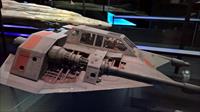
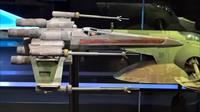
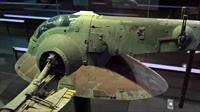
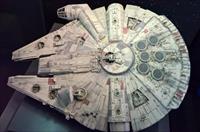
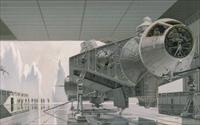
The early design for the Millennium Falcon was vetoed by George Lucas as it closely resembled the Space: 1999 Eagle (described in Robert Brown's detailed Star Wars ship commentaries archive.org; see also Roger Christian and Joe Johnston conversation, YouTube). Early designs and concept models featured side legs, rear engines, side docking ports and a cone shaped nose that looked even more like the Eagle. A hammerhead was added to the model and it appeared on screen as the Blockade Runner, the first ship seen in the film. The Millennium Falcon was redesigned as a saucer shaped craft, the rush job creating serious inconsistencies between sets and model. The name of the Millennium Falcon itself is possibly a reference to the Space:1999 Eagle (the Millennium being the year 1999+1, Falcon being another bird of prey).


- David Tomblin (director) was assistant director on The Empire Strikes Back and Return Of The Jedi.
- Steve Lanning (second assistant director) was second assistant director on The Empire Strikes Back .
- Roy Button (third assistant director) was third assistant director on The Empire Strikes Back and Return of the Jedi.
- Jack Lowin (camera operator) was camera operator on Return of the Jedi.
- Michael Lockey (hairdresser, Seance Spectre, Devil's Planet, Dorcons) was hair dresser on Return Of The Jedi
- Michael Lamont drew the original designs for the Eagle, based on Johnson's concept. He was assistant art director on Empire Strikes Back (1980) and Return Of The Jedi (1983)
- Several SFX assistants followed Johnson to work on The Empire Strikes Back: Nick Allder, Andrew Kelly, Brian Eke, Guy Hudson and Dennis Lowe
- Floor SFX assistant Allan Bryce also worked on mechanical effects for The Empire Strikes Back
- Fred Pearl, a freelance creature sculptor who created Maya creatures, made the Dewback for Star Wars (1977)
- John Stears did freelance effects for Space: 1999, and did many of the practical effects for Star Wars (1977), including R2D2, the landspeeder, the light-sabres and the live action pyrotechnics.
- Les Bowie did freelance effects for Space: 1999, and also worked on Star Wars (1977)
- Andrew Ainsworth created various creatures for Space: 1999 including the creature head for Beta Cloud (for Dave Prowse, who at the time had not been cast in Star Wars, although Ainsworth had already created the Darth Vader helmet and armour). The creature head was based on a left-over Star Wars Rebel helmet. Shepperton Design Studios
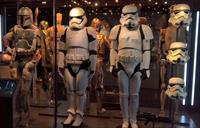
- Brian Blessed (Rowland, Death's Other Dominion and Mentor, The Metamorph) was the voice of Boss Nass in The Phantom Menace (1999).
- Mercedes Burleigh (dead survivor, Mission of the Darians) was a rebel officer on the ice planet in The Empire Strikes Back (1980), a Gamorrean Guard in .
- Les Conrad (Clansman, Journey to Where) was a stormtrooper in Star Wars (1977), a Hoth rebel in The Empire Strikes Back (1980), a Gamorrean Guard in Return Of The Jedi (1983), and an unidentified role in The Phantom Menace (1999).
- Jenny Cresswell (Alphan, various episodes) appeared as Han Solo's girlfriend in a cut scene of Star Wars (1977)
- Michael Culver (Pete Irving, Guardian Of Piri) appeared as Captain Needa in The Empire Strikes Back (1980)
- Peter Cushing (Raan, Missing Link) starred as the Grand Moff Tarkin in the first film. He also appears (as CGI) in Rogue One A Star Wars Story (2016).
- Robert Davies (Mr Hyde, Journey To Where) appeared the cantina in Star Wars (1977)
- Norwich Duff (Texas City Operative, Journey To Where) appeared as a rebel officer in The Empire Strikes Back (1980)
- Roy Everson (Guard, The Exiles) was a stand-in for Michael Culver in The Empire Strikes Back (1980) and for Dave Prowse and Peter Mayhew in Return of the Jedi (1983).
- Harry Fielder (George, Seance Spectre, also in Lambda Factor, Immunity Syndrome and The Dorcons) was a Death Star Trooper in Star Wars (1977)
- Anthony Forrest was Luke's friend "Fixer" in scenes that were cut, and a stormtrooper who is told these are not the droids he is looking for.
- Julian Glover (Jarak, Alpha Child) appeared as General Veers in The Empire Strikes Back (1980)
- Alan Harris (Alphan, many Year 1 episodes) was Leia's rebel escort and a Stormtrooper in Star Wars (1977), Bespin Guard and C3PO stand-in and body double for Harrison Ford in the carbonite in The Empire Strikes Back (1980), C3PO stand-in in Return Of The Jedi, and stand-in for Terence Stamp in The Phantom Menace (1999).
- Drewe Henley (Joe Ehrlich, Bringers Of Wonder) played a small role as Red Leader in the Star Wars (1977), and also appeared (in footage from the 1977 film) in Rogue One (2016).
- Christine Hewett (female Kaldorian, Earthbound) played one of the Tonnika Sisters in the Cantina sequence in Star Wars (1977) (alongside fellow Kaldorian Angela Staines)
- Nick Hobbs (Clive Kander, Bringers Of Wonder) was a technician in Rogue One A Star Wars Story (2016)
- Ken Hutchison (Sanderson, Seance Spectre) played a small role as an Imperial Officer in a conference room with Vader and Tarkin in Star Wars, but was cut from the final movie. He was also going to be in the blockade runner, but Lucas disliked his beard and cast Al Lampert (presumably the conference scene was later)
- Paul Jerrico (guard, Dorzak) played an AT-AT pilot in The Empire Strikes Back (1980).
- Alf Joint (Steiner, Breakaway and Overseer, The Metamorph) was a stuntman on Return of The Jedi (1983)
- John Ketteringham (Long, several year 2 episodes) appeared as Gold Star Three and a Death Star officer in Star Wars (1977)
- Jeffery Kissoon (Dr Vincent, year 2) appeared as Rear Admiral Guich in The Force Awakens (2015)
- Jack Klaff (security guard, Seed Of Destruction) played a minor role in the briefing room scene in the first film.
- Al Lampert (Ken Burdett, Bringers of Wonder) played the imperial officer alongside Darth Vader when he talks to Leia in Star Wars (1977).
- Christopher Lee (Zantor, Earthbound) appeared as Count Dooku in Attack Of The Clones (2002) and Revenge Of The Sith (2005).
- Richard Le Parmentier (Sam Malcolm, Dorzak) played a small role as Admiral Motti in the first film.
- Angus MacInnes (Jelto, Devil's Planet) played a small role as Gold Leader in the first film, and also appeared (in footage from the 1977 film) in Rogue One (2016).
- Christopher Matthews (Main Mission Operative in Breakaway, Matter Of Life And Death) was Rebel pilot Red Twelve in Star Wars (1977)
- Jack McKenzie (technician, The Last Sunset) played Cal Alder in The Empire Strikes Back
- Alan Meacham (Martin Landau's stand-in and occasional roles) was a stormtrooper in The Empire Strikes Back
- Billy J. Mitchell (Professor Hunter, Bringers of Wonder) was a rebel pilot in Return of the Jedi
- Geoffrey Moon (short alien, The Metamorph) was in the cantina scene in Star Wars (1977)
- James Muir (Darian Survivor, Mission Of The Darians) played a rebel pilot in Star Wars (1977)
- Stuart Myers (Alphan, various episodes) played a citizen of Mos Eisley in Star Wars (1977)
- Quentin Pierre (security guard Quinton or Pierce, both Years) was a stormtrooper (he was initially hired by Peter Diamond as a stuntman) in Star Wars (1977), a Bespin Guard in The Empire Strikes Back (1980) and stand-in for Billy Williams, and one of the Emperor's Royal Guards in Return of The Jedi
- Dennis Plenty (security guard The Dorcons) did the original wardrobe tests for the stormtrooper armour for Star Wars (1977)
- Dave Prowse (Creature, Beta Cloud) starred as Darth Vader in the first three films (James Earl Jones supplied the voice)
- Michael Reynell (doctor, The AB Chrysalis and other episodes) played an imperial officer in Empire Strikes Back (1980).
- Terry Richards (Thaed, Matter of Balance) played a Wampa creature in Empire Strikes Back (1980), but was cut from the film.
- Shane Rimmer (Kelly, Space Brain) played a minor role as a technician in the first film.
- Doug Robinson (McDonald prison guard, Journey To Where) was a stuntman in The Empire Strikes Back.
- Pam Rose (Command Center Operative, many Year 2 episodes) played a minor role as an alien (named Leebub Sirln) in the Cantina sequence in the first film.
- Ian Ruskin (Revered One, Death's Other Dominion) was the voice of Chancellor Valorum in an episode of Star Wars: The Clone Wars (2014).
- Michael Sheard (Dr Darwin King, Dragon's Domain) appeared as Admiral Ozzel in The Empire Strikes Back (1980).
- Gerald Stadden (Male Mute, Mission Of The Darians) played an Ewok in Return of The Jedi (1983)
- Angela Staines (female Kaldorian, Earthbound) played one of the Tonnika Sisters in the Cantina sequence in the first film (alongside fellow Kaldorian Christine Hewett).
- Mike Stevens (Main Mission operative and stand-in, many episodes) was a Rebel officer and in Jabba the Hutt's palace.
- Barry Summerford (prisoner, Devil's Planet) was a stormtrooper in Star Wars (1977)
- Ron Tarr (Survivor, Mission of the Darians) was in the cantina scene in Star Wars and appeared with Jabba the Hutt in deleted scenes from the same film that were restored with CGI in 1997/2004.
- Kelly Varney (Superswift crew, Bringers Of Wonder part 1) was a rebel pilot in Star Wars
- Paul Weston (stuntman, various episodes) was a stunt coordinator on Return Of The Jedi.






